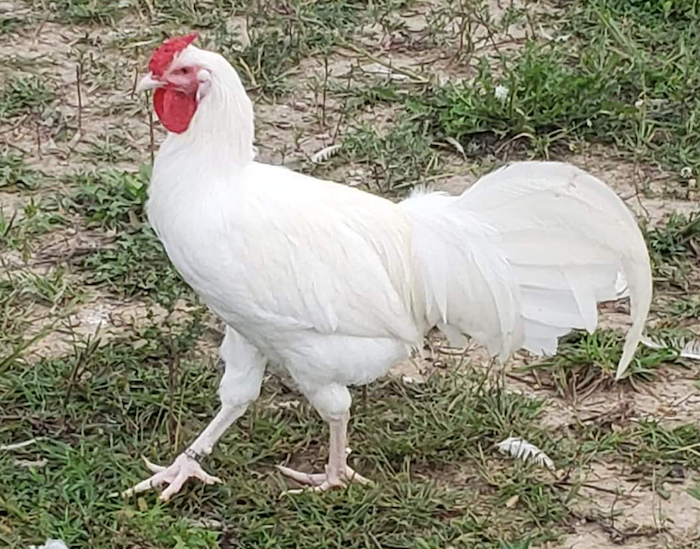White Minorcas were admitted to the American Standard of Perfection in 1888. In reality, they are a far older breed than the Barred Plymouth Rocks or any other American breed of poultry.
Under the name of White Spanish, they were known as far back as the middle of the last century. In old pictures of that period, we notice that their faces are red instead of white like the black variety pictured with them.
Black Minorcas were imported to England during 1834-35 from the Minorca Islands. They were brought to a great state of perfection through selective breeding by the fanciers of that country.
Whether White Minorcas are sports of the black variety is not known, although chances are that they are not, since there were plenty of other white breeds in existence which could have entered into their make- up. White Minorcas were first brought to America by Francis A. Mortimer of Pottstown, Pennsylvania in 1885, and shortly after its introduction to America, it enjoyed a well deserved boom.
White Minorcas are splendid layers of large white-shelled eggs. They will lay as many pounds of them as any other breed.

Minorcas have a characteristic shape, different from all other breeds in the Standard of Perfection. Because they are close feathered, they are considerably heavier than they appear to be. The shape of their body is a rectangle, and there is an abundance of fine grained meat on the frame work. Their stately carriage, broad prominent breast and massive body surmounted by an intelligent head, attracts attention everywhere. Their legs are long and of a strong construction. Minorcas mature early for their size, and it is not uncommon for them to begin to lay at the age of four and a half months. They are the largest “non sitting” breed in the Standard.
Years before the Leghorns and Plymouth Rocks became the favorites, the old time white-faced black Spanish breed was considered the finest all-around breed for the farmer. They were used in crossing many other breeds principally for the size of their eggs and for their vigorous constitution. But times and fashions change, and when the feather-legged breeds had their innings, the old timers had to go into retirement for a while, to be resurrected again, when their turn came. At the present time, the smooth legged breeds are again occupying the stage and have for some time past, and our old friends, the Minorcas, still having their old shape and the same old qualities, are once more in the limelight. It’s true that there are a few refinements; as for instance the coarse combs and faces are no longer wanted, and the shape of their body is perhaps a little longer than that of the original birds. On the whole though, no radical changes have been made for the reason that they were good enough from the beginning.
The desired standard weight of the White Minorcas is 9 lbs. for the cock, 7 1/2 lbs. for cockerel, 7 1/2 lbs. for hen and 6 1/2 lbs. for pullet. Their legs should be pinkish white in color, not slate like the black variety. Their skin is white. One of the most distinguishing points of the Minorcas is their head. It should be rather large and longer than high, and nicely rounded in front and back. The comb should be large compared with other breeds. It should have a strong base in the male to keep it straight. In the female the comb should lop, making a fold or loop over the beak. The texture of the comb and face should be velvety to the touch, but not absolutely smooth, as such a surface in the face offers an easier foothold for ‘permanent white’. The earlobes should be almond shaped, of good size and texture, sharply set off and defined, with enamel-like appearance as white as possible. All early white breeds were troubled with ‘brassiness’. This defect, however, has been bred out, and we rarely see it anymore.
The most common defects of the breed are about the same as we find on other large breeds. Some examples are: Coarse type, short in body, flat in breast, narrow/shallow bodies, legs too short, curved back, tail carried high, scanty plumaged tails, leghorn type, pinched tail, knock-knees, legs set back too far, too many or irregular serrations in comb. rear of comb turning in male. Other defects are side sprigs and thumb marks, birds of small size, red in earlobes, white in face, off colored feathers in plumage, stubs, wrinkled faces & wattles, brassiness, etc.
by L.A. Stahmer, Poultry Artist & Judge
This article is being used with the permission of the FEATHER FANCIER newspaper, editor Paul Monteith.
